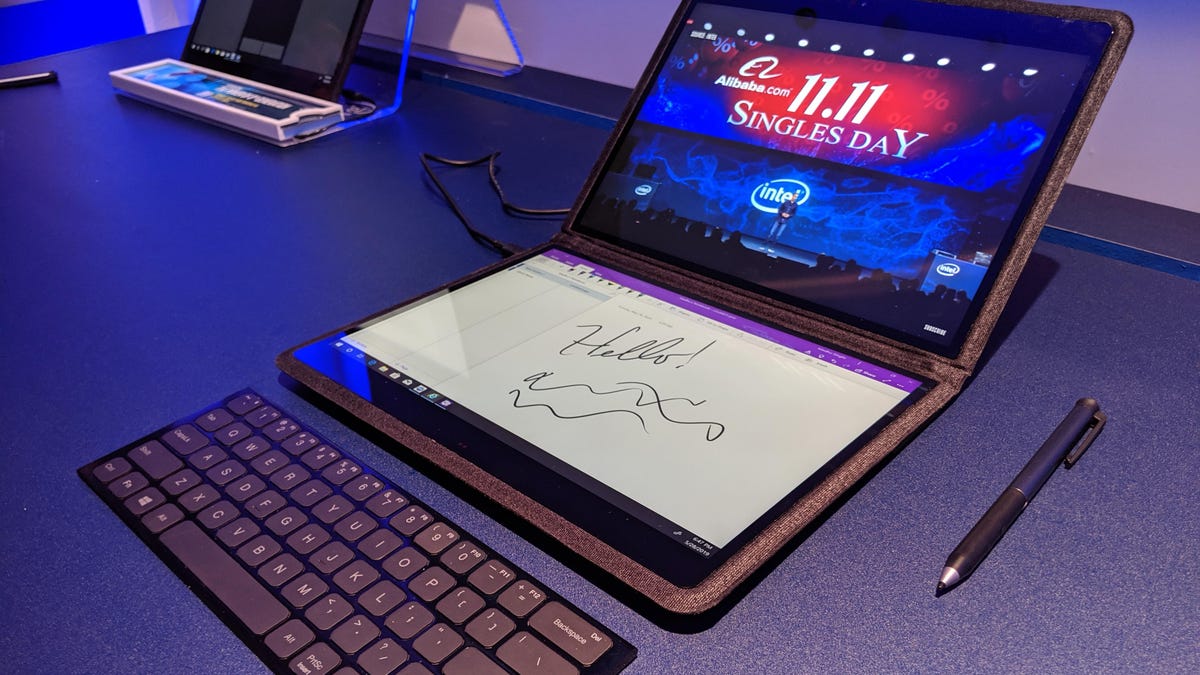Intel's beautiful dual-screen concepts show what laptops could be in 2 years
The company had dual-screen versions of productivity and gaming laptops.

Intel has changes in store for laptops.
Laptops have gotten thinner and smaller, but their basic design hasn't really radically shifted. Intel thinks that will change within two years.
At Computex 2019, the chipmaker brought several proof-of-concept devices that show what laptop makers like Asus , Dell and HP can do with its tech. The common denominator across the devices? Dual screens. Keyboards, it seems, will soon be so 2019.
First up is the Ultrabook concept, Twin Rivers, a futuristic take on thin-and-light laptops like the Dell XPS. It combines two 12.3-inch touchscreen displays, with the bottom display having an on-screen keyboard, like one you get on a tablet. However, the concept also comes with a physical bluetooth keyboard that fits atop the display for longer sessions.
This concept isn't unheard of. Lenovo's Yoga Book series is comprised of laptops that have onscreen, e-ink keyboards rather than a physical one. Jim Johnson, general manager at Intel, told me attachable keyboard design was inspired by feedback from Lenovo. He also said we'd see designs like this on the market "imminently," but another Intel rep gave a more tempered "one to two years" timeframe.
Twin Rivers works in laptop form, tent form and cookbook form, the latter of which Intel showed off with a comics app. These were developed using Intel's Whisky Lake CPUs, and a rep from Intel said the newly announced and more efficient Ice Lake chips will make devices like this easier to craft.
A Bluetooth keyboard fits snugly atop the second display.
The new cookbook.
The second concept, deliciously titled Honeycomb Glacier, is for gamers. It combines a 17.3-inch display with a second "12.3-inch" screen (it's not as deep as a traditional display of that size) that's propped up by some ergonomic wizardry.
The most impressive feature is eye tracking. The second display can hold three programs, and there's a camera in between the two screens that tracks where you're looking. It knows what window you're looking at, whether it be on the top screen or on the bottom screen, and automatically puts you in control of that window. That makes navigating the two screens easy, in a very futuristic sense, and also means you don't have to use the shirked-to-the-right trackpad as much.
AND the ergonomics in action pic.twitter.com/R3jHK3Bca4
— Daniel Van Boom (@dvanboom) May 29, 2019
Dual-screen gaming laptops are already a reality. The newest HP Omen has a 6-inch display above the keyboard, and Asus' new ZenBook Pro Duo has an impressive 14-inch 4K screen below its 15.6-inch main display that essentially acts as a screen extension. (The ZenBook Pro Duo isn't marketed as a gaming laptop, but it can be configured with an Nvidia RTX 2060 so it's not not a gaming laptop.)
However, unlike Twin Rivers, Intel wouldn't say when we can expect something like this on the market. The screen technology is already there, as the aforementioned ZenBook Pro Duo has basically the same setup, but the ergonomics may be harder to figure out -- at least from a marketing and simplicity-of-use perspective.
Again, Intel isn't manufacturing these laptops, they're just concepts (for now). Intel did announce a bunch of actual products at Computex though, including new 10th-generation Ice Lake CPUs, which introduce AI features to laptops, plus the Project Athena class of devices.

